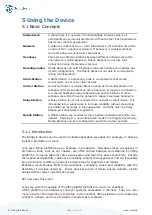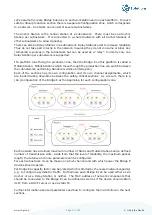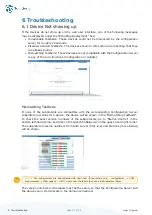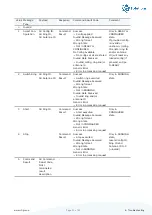
5 Using the Device
5.1 Basic Concepts
Subnetwork
A subnetwork is a network of multiple Bridge E devices where all
participants can communicate directly with each other. Each subnetwork
has its own channel assignment.
Network
A network consists of one or more subnetworks. All subnetworks within
a network form a handover domain. If handover is enabled, stations
can roam between subnetworks seamlessly.
Handover
The roaming of Mobile Stations between different subnetworks within
one network is called Handover. Mobile Stations do not lose their
connection during the Handover process.
Reconfiguration
Mobile Stations can switch between networks (where each network has
its own configuration). The Mobile Station is not able to communicate
during reconfiguration.
Static Station
A Static Station is a stationary node in a subnetwork that can be
connected to one or more client devices.
Anchor Station
An Anchor Station is a Static Station acting as the central station of a
subnetwork for Mobile Stations using Handover. It requires a connection
to a shared backbone network between all Anchor Stations of other
subnetworks within the same network to support seamless handovers.
Relay Station
A Relay Station is not not connected to a network or client device. It is
introduced into a subnetwork to increase reliability without consuming
any additional resources in the subnetwork. Currently only one Relay
Station per subnetwork is supported.
Mobile Station
A Mobile Station can seemlessly roam between subnetworks within one
network. Roaming to a new subnetwork needs to be triggered externally.
Mobile Stations can be reconfigured to switch to another network.
5.1.1 Introduction
The Bridge E devices can be used in multiple application scenarios, for example, in storage,
logistics, production or tools.
Let’s take lifting platforms as an example in production. Nowadays large workpieces in
production lines, such as car chassis, are often carried between workstations by lifting
platforms. Complex cable layouts ensure power and realtime data connectivity. Despite
their speed and reliability, cables are constantly subject to wear and tear and are frequently
prone to failure, resulting in expensive downtimes for diagnosis and repairs.
EchoRing revolutionizes M2M communications, combining speed and reliability with the
flexibility of wireless networks. Fewer physical points of failure ensure durable, mobile
setups with far fewer maintenance cycles.
But how does this work?
Let’s stay with the example of the lifting platforms that are used on a shopfloor.
Lifting platforms are stationary conveyor systems embedded in the floor. They are com
monly used for final assembly of vehicles. In this context, lifting platforms are contiguous,
similar to a chain, and move forwards in tandem at low speeds.
5. Using the Device
Page 16 of 45






























